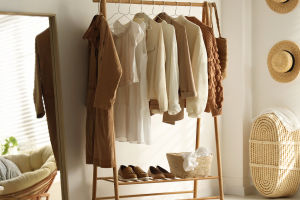
Hey Lykkers!
Ever dreamed of having your own walk-in closet but felt your room was just too tiny?
We've all been there, standing in a cramped bedroom wondering if it's even possible to squeeze in a dressing space. But the truth is—no matter how small your space is, it's all about how we plan it.
Let's dive into the real tips that help us turn even the smallest corners into functional, stylish dressing areas.
How Do We Plan the Layout for a Closet?
When we design a closet, we start by looking at the room's layout. There are two main types of dressing room traffic flow:
1. Straight-through design—where the bedroom, closet, and bathroom are aligned. This setup is super convenient. We can undress in the closet, shower, and then hop into bed without catching a chill. But if the closet is close to the bathroom, moisture can be an issue. We'll need a good dehumidifier to keep our clothes fresh.
2. Separate closet design—perfect for those of us with bigger homes. We can dedicate a full room or even just 3.3 square meters for a walk-in closet. This keeps humidity out, but the flow might feel less smooth.
Which Closet Shape Works Best?
Just like kitchens, closets come in various layouts. We choose based on space, how we move around, and how much storage we need. Here are the five common types:
• Single-wall closet—Great for small rooms. It's a one-side layout with hanging rods, drawers, and shelves all in one row.
• L-shaped closet—Makes use of corners and helps divide space for different seasons or family members.
• Double-wall closet—Gives us more storage on both sides with a walkway in between. Just make sure the doors don't bump into each other.
• U-shaped closet—Found in larger homes. We get storage on three walls and plenty of space to move.
• Island closet—The ultimate dream! A central island with drawers for accessories. But it needs generous room to avoid cramping.
How Big Should the Closet Be?
We often hear, “Is my room big enough for a walk-in closet?” Honestly, 3.3 m² is a practical starting point. What matters most is how we move and access our clothes.
• Closet depth: At least 60 cm, so hangers and clothes don't get tangled.
• Walkway width: Ideally 80 cm or more. This lets us move and dress comfortably.
• Minimum width: For a single-wall design, 140 cm total. For double-wall or U-shaped, aim for 200 cm and up.
If your space is tight, open-style wardrobes can be a good choice to make things feel more spacious.
What Materials Can We Use for Closet Dividers?
When building a closet inside the bedroom, solid walls aren't our only option. Depending on your style and privacy needs, here's what we can choose:
• Glass sliding doors—They make the room feel bright and airy. Choose from frosted or clear styles with different frame colors.
• Curtains—A budget-friendly DIY way to section off your closet, especially in smaller rooms. They give privacy while letting air flow.
• Wardrobes as walls— Multi-use! Our closet becomes the divider.
• TV walls or bed headboards—If we already plan to have one, we can use the back of it to carve out a small closet space.
Just don't forget: Whatever style we choose, we still need a walkway that allows easy movement!
Closet Must-Haves: Storage and Makeup Space
Let's not stop at just hanging clothes. When planning, we should also think about:
• Drawers and baskets for socks, underwear, and accessories.
• A vanity table for getting ready. Combining it with the closet saves space and keeps everything in one spot.
• Open shelves for quick-grab items or display pieces.
Every corner should be functional. If it doesn't serve a purpose, it becomes clutter.
Let's Wrap It Up
Lykkers, whether our room is big or small, a walk-in closet isn't out of reach. It's not just about space—it's about smart design. With the right layout, walkway, and divider choices, we can build our own little dream corner. Don't worry about the size. Worry about how to make it work for us.


